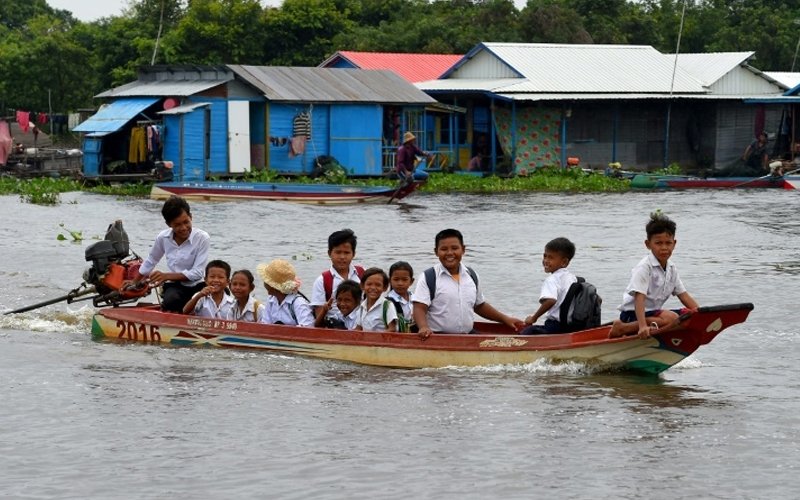
KOH CHIVANG: As night falls over his floating village, fisherman Leng Vann puffs on a cigarette and heaves a sigh for Tonle Sap, the great inland lake that has sustained Cambodia for centuries.
More than a million people live on or around the lake, the world’s largest inland fishery, but water levels have plummeted and fish stocks dwindled because of climate change and dams upstream on the Mekong.
Tonle Sap was once renowned for its abundance of fish and wildlife – 43-year-old Leng Vann recalls catching hundreds of kilos a day in his nets.
His house, which floats on the lake, sits five metres (16 feet) lower than it should in mid-October, at the end of the rainy season, and when he draws his net from the waters, it is empty.
“We fishermen survive by water and fish. When there is no water and fish, what else can we hope for?” said Leng Vann.
“Our future is dark,” he said, as he rowed his boat back to his modest home.
Reversing fortunes
The lake, a world heritage ecological reserve, depends on an unusual seasonal reversal — in the dry season, it drains into the Mekong via a fast-flowing river artery.
But when the rains come from May to October, the mighty Mekong is so powerful that the water flows backwards, replenishing the lake.
It swells over four times its smallest size to 14,500 square kilometres (5,600 square miles) at the height of the floods, according to the Mekong River Commission (MRC)– an area bigger than Lebanon.
But lately the reverse flows have been seriously delayed.
Last year the amount of water that flowed into the lake was down around a quarter from the average levels seen around the turn of the century.
The reverse flow effect has been at its lowest since 1997, leading to “extremely dry conditions”, the MRC says.
Weather conditions linked to climate change, such as a major drought last year and the “El Nino” climate effect, have contributed to the crisis.
Environmentalists also point to the dozen or so major dams built across the mainstream Mekong as a factor in slowing the flow, along with smaller irrigation dams built on tributary rivers.
Habitats lost
The change in water levels is having a major effect on surrounding wetlands, precipitating a decline in endangered species living around the lake.
Nearly one-third of the Tonle Sap’s natural habitats vanished in the 25 years to 2018 and half of the lake floodplain was now under rice cultivation, according to a recent study by the Wildlife Conservation Society.
“Without urgent, coordinated action… the ecosystem that has sustained Cambodia for generations may be lost,” it said.
Low fish stocks have pushed most of the 2,600 fishing families living in Koh Chivang – a community of five floating villages on the lake – to grow chilli and other crops to supplement their living.
They are now farming land that used to be fish breeding grounds, and the community’s deputy leader Hun Sotharith says the illegal clearing of surrounding forests for agriculture was on the rise.
“If we don’t protect the remaining natural resources, there will be difficulties in the future,” he told AFP.
Rangers also warn that other animal habitats are under imminent threat, including a huge bird sanctuary where desperate fishermen are seeking new places to cast their nets.
Changing times
Floating villages have adapted to the ebb and flow of the lake for generations, mostly depending on fishing or rowing around the village in canoes to sell food to earn a living.
Whole communities with schools, hairdressers, coffee shops and even dentist surgeries bob around on Tonle Sap, where fleets of canoes and small motorboats ferry people around.
But drought and disappearing fish are now threatening a traditional way of life in Koh Chivang, where youngsters are leaving for urban jobs while their parents stay to keep their homes afloat.
“Children from this community go to work in factories now because there are no fish in the lake,” said fisherman Sim Suom, 59, adding that his daughter now works in a cigarette factory in Siem Reap.
Leng Vann says he may soon need to travel to Siem Reap – about a one-hour boat ride from his home – to look for work for a few months.
“We fishermen depend on water, fish and forests, so when these are gone, we can expect nothing,” he said. “It’s over.”


